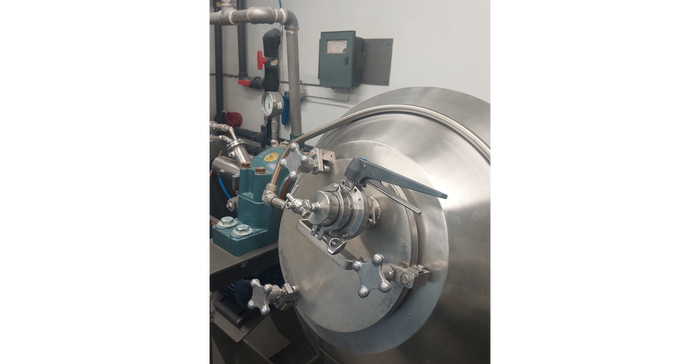From Nanoparticle Agglomeration Problem to Perfect Tungsten Powder Flow
An expert in 3D printing was looking for a way to “coat” its submicron tungsten powder for improved flow during the 3D printing process.
January 19, 2024

Tungsten is a heavy metal powder that, in our testing, had a typical density ≈ to 700 lb/cu ft. It is frequently used in fields like aerospace and medicine because of its exceptional strength, hardness, corrosion resistance, and high melting point (6,170˚F). Yet, its processing difficulties--particularly at the nanoscale--can limit its potential for uses like 3D printing. Advanced Powder Solutions (APS) helped a customer achieve optimal flowability for ultra-fine tungsten powder. Providing a solution for manufacturing parts to be used for underwater purposes such as waves and tidal turbines to generate electricity.
The Challenge
The customer, an expert in 3D printing, was looking for a way to “coat” (sometimes referred to as “treat”) its submicron tungsten powder for improved flow during the 3D printing process. The small size of the particles presented a significant challenge. Agglomeration--the tendency of particles to clump together--threatened to disrupt the delicate flow needed to maintain even distribution and bed density for successful 3D printing.
Meeting the Call
Recognizing the potential of this project, APS was determined to find a solution. Known for tackling complex particle problems, the APS team understood the need to adapt existing machinery to the unique weight and handling demands of tungsten. By carefully embarking on a collaborative journey with the customer and analyzing customer-specific requirements, APS helped in developing a customized process.
Navigating the Nanoscale Maze
The path to success wasn't without its twists and turns. The APS team grappled with several key challenges:
Agglomeration: Specialized techniques are required to break down the microscopic clumps and ensure uniform particle distribution.
Coating the Miniscule: APS had expertise in larger particles but adapted its coating processes to achieve optimal results for submicron metal particles with novel approaches.
Heavy Weight Handling: Tungsten's density presented physical and logistical hurdles. The APS facility--equipped for handling large quantities of heavy materials--proved crucial to the project's success.
Scaling for Success: The customer envisioned commercial-scale production, requiring a process that could be readily ramped up without compromising quality or flowability.
Know How
APS is GEMCO’s sister company and utilizes its machinery. Its equipment represents the shortest processing time for AM, metallic, ceramic, and plastic powder mixing and drying available. GEMCO’s blenders are designed to apply turbulence to all corners of the mix. This is accomplished through the combination of simultaneous macro-blending and micro-blending, which allows for improved distribution.
Macro-blending is achieved through the rotation of the shaped vessel, enabling the material bed to fall away from its walls. The blender moves at a precise speed, with the vessel wall at a precise angle so that the material cascades over itself. There is no additional force from paddles, plows, or spiral ribbons—only gravity.
Micro-blending (if needed, as in this case) is performed via agitator blades located in the blending zone center of the vessel, which is where fine processing and distribution of the materials occur.
APS used its knowledge and commitment to solve its clients’ challenges by offering the following solutions:
GEMCO Formulator: APS used GEMCO’s formulator, a sophisticated piece of equipment that helps with mixing and drying various materials to provide consistent and high-quality products for different applications. The system offers various processing capabilities, such as blending, liquid addition, agglomeration, drying, and cooling, which enhance production efficiency and provide greater flexibility in the manufacturing process.
Coating: Working closely with the customer, APS optimized the coating process, achieving uniform bonding of a variety of coatings (such as polymers and silicone) onto the tungsten particles.
Expert Guidance: The APS team of engineers and technicians provided ongoing support and technical expertise throughout the project, ensuring every step was optimized for success.

GEMCO’s formulator at the Advanced Powder facility (image courtesy of Advanced Powder Solutions)
The customer had flowability issues with tungsten powder while trying to achieve their desired coating characteristics for 3D printing. However, with the help of APS's technical expertise and GEMCO's versatile and highly efficient equipment, they were able to use a specially adapted process for fine tungsten nanoparticles. The customer was impressed by APS's adaptability and commitment to solving its unique challenge.
Future Horizons
Innovation: The customer's cutting-edge approach highlighted the dynamic nature of the 3D printing industry and the need for continuous adaptation to stay ahead of the curve.
Customer-Centricity Matters: APS's success stemmed from understanding and addressing the customer's specific needs, fostering a strong and mutually beneficial partnership.
Continuous Improvement: This project expanded APS’s expertise in handling ultrafine powders, equipping them for future challenges in the ever-evolving particle processing landscape.
Conclusion
This example demonstrates how teamwork and expertise may be invaluable in overcoming the hurdles of processing complex materials like tungsten. This challenge has demonstrated the GEMCO formulator’s versatility, resulting in improved powder flowability, elimination of clogging, increased processing speed, consistent high-quality product outcomes, and reduced risk of fire or explosion.
George Paffendorf, is VP of operations, Advanced Powder Solutions, and VP of process engineering & design, GEMCO. For more information, call 800-654-3626, email [email protected], or visit okgemco.com.
You May Also Like


